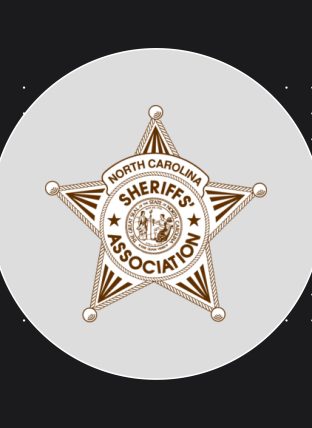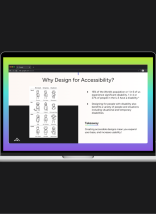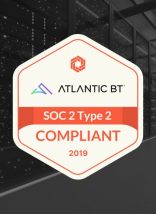When I think about cities and city services, I can’t help but see them as user experience projects. As a UX-oriented person, maybe that’s just me being a hammer and seeing a UX nail, but as more and more diverse citizens rely on these municipal sites, city governments will have to take UX seriously to serve citizens in the future.
This UX perspective should extend from city hall buildings to services in the community to digital spaces like social media and city websites. I’m not only saying this because I think it’s the right thing to do, it’s also what citizens are increasingly coming to expect. Research from Accenture has shown that people are coming to expect more and more from digital government. Over three quarters of US citizens expect the same or better service from government websites as they do from commercial sites, and that number is growing. Some government institutions like the State of Georgia are catching on to this trend, though that appears to be more the exception than the rule.
Since we know how important city websites are, my user research team and I are always watching where these municipal sites seem to be headed. This can be a hard thing to pin down because there is so much variation in the execution of city websites, but here are a few trends that stand out.
Municipal Sites Will Focus on Findability
One of the hardest challenges of municipal sites is creating effective navigation systems. These sites struggle because they need to meet the needs of many user segments as well as the needs of many internal departments. Pick a city site at random, and chances are you will notice critical information buried in deep site structures. Deep structures aren’t necessarily always bad, but designing navigation for municipal sites is especially challenging because of the abundance of jargon in field. This in mind, here are specific ways municipal sites can improve findability:
Search
Search is an obvious way to get around the problems of navigation and hard-to-find information. While this might seem behind the times to include, you’d be surprised how many cities don’t have basic search aids like suggestions, autocomplete and spell check, much less filters to narrow results. With that said, many cities have begun promoting search even more by placing the search bar right in the middle of their home page. Take Las Vegas, for example:
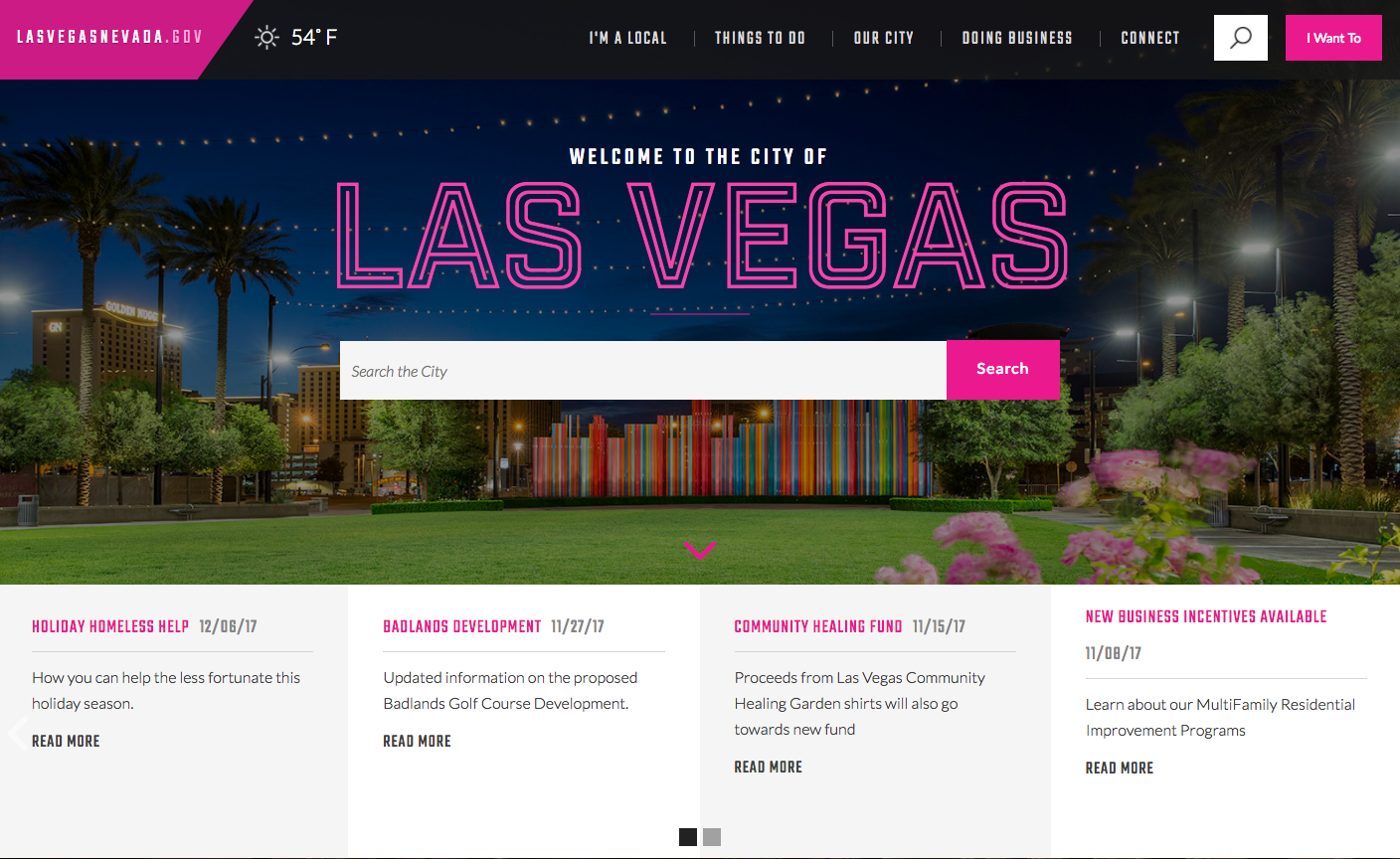
Intelligent Assistants
Many cities (and other government agencies) have begun to develop Alexa integration to help people find information. I have to commend these agencies for forward thinking, as I think voice interfaces are here to stay. At the same time, I can’t help but wonder how useful some of these tools actually are. It’s hard to accurately assess the value of these applications without some user testing, but my first question is: Which applications of these tools provide value and which are just shallow attempts to adopt a trendy technology?
For example, one of the apps currently available advertises providing information about the names of people in official positions. Put simply, that seems mostly useless. Other apps report to provide information about trash collection or street closure schedules. These tasks seem more practical. For example, imagine being able to instantly check whether you need to put your recycling out without having to consult a screen. I believe these tasks are closer to the types of things that people actually use intelligent assistants for: repetitive, fact-based information needs as opposed to subjective questions dependent on individual opinion. If I sound cautious here, it isn’t because I don’t believe voice interfaces could be useful–they could be–I’m just trying to stress the importance of basing these interfaces on real user needs.
“Get It Done” Wizards
Another approach is to present a navigation alternative by allowing users to select a catered guide to locate a page. These guides are usually presented as step-by-step processes (with numbered steps and all). In my view, though these are often presented as task wizards, they are typically just alternative navigation schemes that use actions as categories rather than the loosely-persona based navigations that city sites usually employ.

These features provide an alternative finding method for users who struggle with or are not inclined to use other methods. That said, if a municipal site relies on these special guides to perform routine tasks, why not simply redesign the site’s information architecture so all categories are labeled as common actions? Are they simply bolting on alternative routes to popular content instead of simply designing their navigations around it?
City Sites Will Get Serious about Content Strategy
As a critical component of any website design, content strategy will also become a major focus of municipal sites in the coming years. And many of these sites have a ways to go—city web pages with a strong vision of their own strategy are more the exception than the norm. Here are some important ways that leading municipal sites will align their content strategy with actual user needs:
Timely Topics That Matter to Many Users
Cities need to prioritize and produce content that matters to the majority of their citizens. This means focusing on the key content strategy question: What do users actually come to the city website for? The answers should guide municipal site owners in deciding what content to prioritize.
One mistake I often see on city websites is there is too much focus on news or announcements (such as a press release of the mayor’s speaking engagements) rather than directly actionable information. Too often these news stories dominate screen space on multiple pages despite being of interest to only a small subset of users.
This doesn’t mean the latest news isn’t useful content, but municipal sites must prioritize common user needs over pure timeliness. For example, Boston’s site prioritizes things like parking meter schedules, street cleaning, and trash schedules over the “typical latest news” information—though these schedules should of course be kept up to date.
Embrace Citizen Communication
There is no more direct way to prioritize user needs than listening to those users in real time. Every municipal site understands the need for web-friendly ways for citizens to contact city officials, so most cities have webforms to request service, report things, and contact municipal employees—in addition to just posting phone numbers.
But beyond these standard methods, how else can municipal sites embrace citizen communication? Many cities (including Wichita, Virginia Beach, and Boston) have chat capabilities that allow citizens to immediately contact city employees for answers. These live chat sessions not only allow users to quickly express their views, but also reinforce that the city leaders are making time for a real person to listen to them. Additionally, they open lanes of communication for users who are not inclined to make a phone call or can’t wait for an email response.
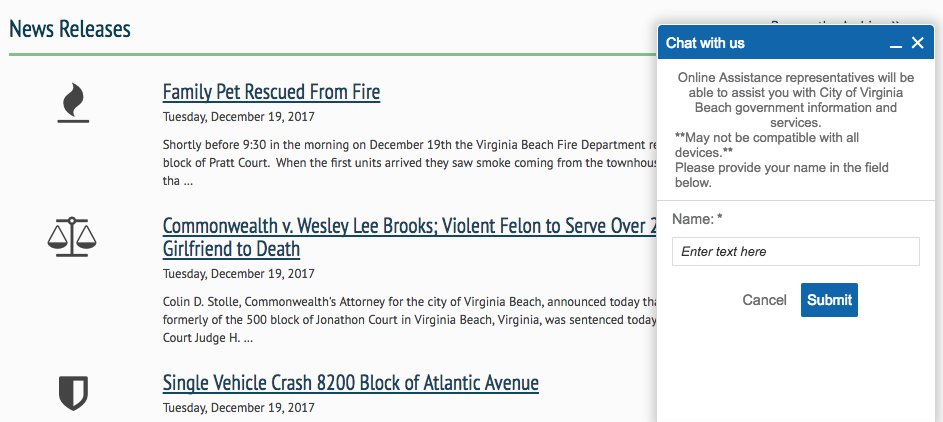
It’s also worthwhile to engage users on social media channels like Twitter or Facebook in order to rapidly circulate important information and get citizen feedback. There’s nothing wrong with building a following by posting jokes or pictures of cute animals in the city, as these followers will later be able to receive your updates when something serious is happening. In addition, cities should develop a plan for how they will respond to unforeseen events on social media. For example, the city of Toronto famously found themselves on the spot after a picture of dead raccoon on a city sidewalk went viral.
The Future of Municipal Sites Is Now
Of the predictions made in this post, very few of the trends discussed rely on cutting-edge technology. Instead of some sci-fi dreamscape driven by neural integration with digital systems or holographic imagery, the future of municipal sites will depend on strong search capabilities, user-centered content strategy, and social engagement—all best practices you can implement right now.
To learn more about how government websites can better serve citizens, please visit our government services page.





